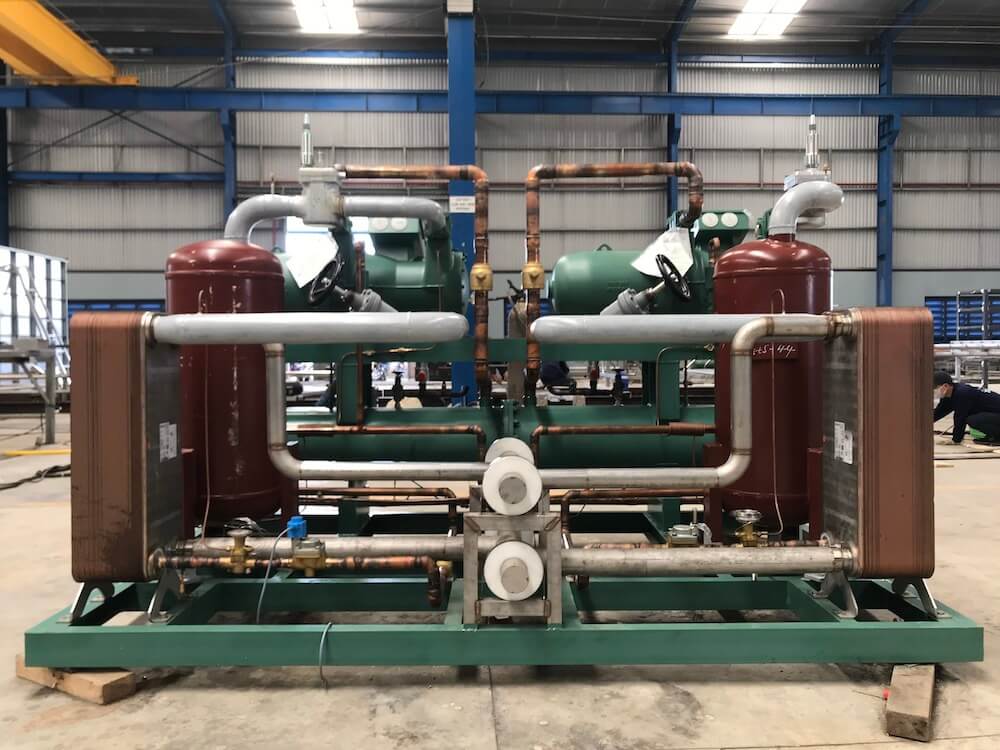The primary feature of the water chiller

- Water circulation cooling devices for air conditioning systems, product chilling in dairy processing plants, beverage manufacturing facilities,… In cases where low temperatures are required, such as ice cream machines, additional components like glycol, CaCl2, …, are added in specific proportions to achieve a solution temperature ranging from -20°C to -30°C.
- The water chilling system serves seafood processing plants, specifically delivering low water temperatures for the ice sheeting system during freezing.
- The heat exchange devices are fabricated using materials like SUS 304 and SUS 316 to comply with HACCP and FDA standards. Originating from the EU, from renowned brands such as Thermowave, Alfa Laval, BUCO, Danfoss, GEA,…
General Inormation
Overview
- Utilized in applications for cooling or heating liquids, condensing water vapor or steam within a moderate range of temperature and pressure;
- Compact and lightweight design;
- Constructed from stainless steel and corrosion-resistant components; available with multiple connection options;
Technical specification
- Cooling water for thermal regulation; food industry;
- Chemical and petroleum industry;
- With gasketed design (not available for NH3);
- Laser welding (available for NH3);
Principle of water chiller unit
- The water chiller unit operates on the principle of changing the physical state properties of matter. The water vapor condenses into liquid form and then solidifies, completing a closed-loop cycle.
- The heat absorption process involves the phase transition from solid to liquid, liquid to gas: it utilizes heat from the surrounding environment, causing that environment to lose heat and become colder. Conversely, the heat dissipation process to the environment involves the phase change from gas to liquid, liquid to gas.
- The refrigeration system absorbs heat from the environment, causing the environment to become colder, thus the liquid will transition into a gas state.
- Then the reverse process occurs: the low-pressure gas state is compressed by the compressor. Through the compressor, the high-pressure gas state is cooled down by the cooling tower or copper tubing blown through the heat exchanger, transitioning into a liquid state to complete the closed-loop cycle. At this point, the gas regulating valve will adjust between the liquid and gas states.
Exceptional Features
This is a device that many people are interested in, using, and exploring for application in construction projects. The exceptional benefits of the machine are evident in the following aspects:
- The machine’s capacity ranges from 5 tons to thousands of tons.
- The device features a compact chilled water piping system, allowing for flexible installation in office buildings, high-rises, etc., without occupying excessive space.
- The system operates very reliably, ensuring long-term durability.
- The water chiller unit is suitable for operation in various large-scale to very large-scale projects such as factories, shopping centers, hospitals, sports training centers.
- Saving energy and cost
Application of water chiller unit:
Water chiller unit is suitable for large-scale projects such as:
- Utilized in supermarkets, commercial centers
- Utillized in cold water tanks: for storing and distributing chilled water.
- Utilized in control panels, electrical cabinets: Controls for cooling towers, centrifugal water pumps.
- Applied in manufacturing sectors: plastics, chemicals, textiles, pharmaceutical technology, electronics industry, building cooling systems,…


